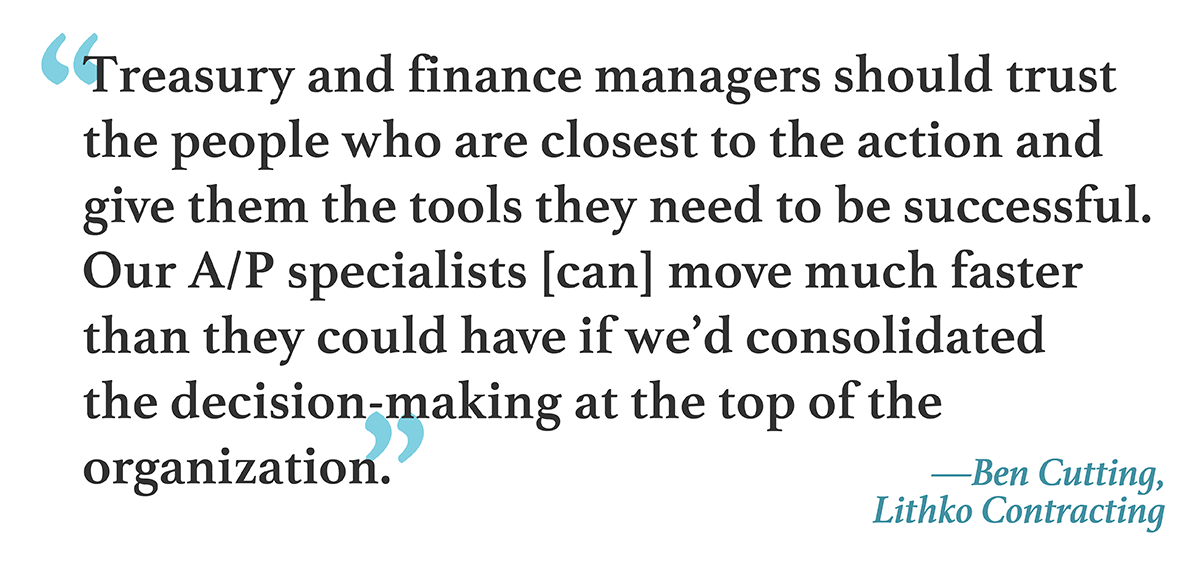A Concrete Example of Innovative Thinking
Home >> News >> Lithko >> A Concrete Example of Innovative Thinking
Posted By TPO Admin

Behind the virtual and brick-and-mortar storefronts of the modern retail economy lies a network of giant warehouses. And underneath those warehouses lies a lot of very precisely laid concrete. That is the market niche where Lithko Contracting thrives.
“As distribution centers in the e-commerce infrastructure have come to rely more and more on robotics and conveyance, there has been a flight to quality in concrete contracting,” says Ben Cutting, Lithko’s CFO. “Robots that are navigating via lasers are thrown off if the floor is too shiny or if it has seams. That is one example of the types of specialty, midmarket industrial concrete jobs that Lithko focuses on.”
Because of its role in the e-commerce sector, Lithko’s business actually grew during the Covid-19 pandemic. “Concrete is about as old-school an industry as you can get, yet we’ve grown revenue by $1 billion over the past four years,” Cutting says. He believes the expansion is partly attributable to the company’s grassroots approach to management.
“Rather than having decisions come from the top of the house,” he explains, “we try to push decision-making down to the people closest to the action. As our management team says: ‘We don’t build buildings. We build teams to build buildings.’ We believe that if we get people on the front lines the right information, they will make good decisions. So, the role of back-office functions like finance is mostly to develop and disseminate the most accurate, timely, and relevant information possible.”
That approach to distributed decision-making was crucial during the pandemic, when Lithko needed to throw a lifeboat to some of its struggling suppliers. “We continued to give our vendors business, but many of them also service retail environments and residential projects,” Cutting says. “In those sectors, the pandemic was devastating. Some of our smaller vendors were facing a run on cash, and they didn’t have financial flexibility or lines of credit to draw on.”
Lithko’s accounts payable (A/P) team started receiving calls from suppliers that needed help with cash flows. “The A/P specialists could sense the desperation at the other end of the phone,” Cutting says. “People needed money right away.” But simply accelerating payments to those suppliers would have damaged Lithko’s own financials. “Our customers don’t pay us for 60 days, so if we started paying every invoice as soon as we received it, we’d be out 60 days of working capital,” he adds.

Cutting teamed up with Lithko’s A/P managers to evaluate the company’s options for empowering A/P specialists to accelerate payments. After considering several alternatives, they decided to launch a virtual, or “ghost,” payment card program.
“We worked with KeyBank to design a program for ghost-card payments,” Cutting explains. “We established terms for the card that enable us to preserve Lithko’s balance sheet while accelerating payments to vendors that need immediate help. And in designing the program, we pushed a lot of the decision-making down to the front lines of A/P. We gave them the authority to decide which specific payments are appropriate to use the ghost card on.”
The virtual card functions much like a consumer credit card. When an A/P specialist decides that it’s the appropriate mechanism for paying a particular invoice, he or she will use a virtual card, rather than a paper check, to make the payment. The specialist will charge the payment to a one-use-only KeyBank credit card number by running it through a virtual terminal. Less than a week later, the supplier will receive an ACH payment equivalent to the invoice amount discounted by a small interchange fee. Meanwhile, Lithko will delay its payment of the invoice until the end of the card’s billing cycle, so its working capital won’t be affected by the accelerated payment.
The A/P team has used this approach to accelerate around $5 million a month in payments to as many as 400 vendors. “A lot of the materials we buy—like concrete, steel, and rebar—come from very small companies,” Cutting says. “These aren’t retail establishments; they are family operations where they’re paying the company’s bills at night over the kitchen table. They don’t have the capitalization of a large company, and getting approved for a bank loan might take a long time, even if they are a good-quality credit.”
The faster access to cash has made a huge difference for some of these suppliers. And the suppliers’ ongoing success has enabled Lithko to continue its explosive growth.
“We have avoided a lot of operational issues,” Cutting says. “Amid the carnage of the pandemic economy, we didn’t have to tell our colleagues in operations to find another vendor because our small supplier was no longer making payroll. By keeping our vendor network paid and functioning, we avoided disruptions to our business as well.”
One more benefit of the virtual card is earlier revenue recognition. Lithko uses percentage-of-completion accounting, Cutting explains, which means the company recognizes revenue from an accounting perspective only when the corresponding costs are known. Once suppliers recognized the speed at which they could get paid, they were more inclined to bill in a timely manner. As a result, Lithko was able to accelerate revenue recognition on several million dollars’ worth of sales by almost 60 days.
Cutting attributes much of the initiative’s success to the fact that it empowered A/P staff to make decisions about payment methods. “Treasury and finance managers should trust the people who are closest to the action and give them the tools that they need to be successful,” he says. “Our A/P specialists were on the front lines, hearing about the issues our vendors were experiencing. They were able to move much faster than they could have if we’d consolidated the decision-making at the top of the organization.”